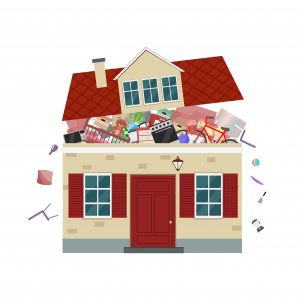Human beings are not, as a rule, good with change. Even life’s most joyful milestones and transitions tend to cause their share of stress. And when you add in difficult emotions, things get intense pretty quickly.
One life experience that is often underestimated in terms of its emotional impact is moving. I’ve recently experienced saying goodbye to my childhood home, and it wasn’t easy. Even though my brother and I spent the last several years encouraging our parents to sell their home, I wasn’t ready.
Logically, the move made sense. Downsizing and moving into a different kind of housing arrangement would keep them safe and free them up from the arduous responsibilities of things like landscaping and snow removal. Even so, as we prepared to hand the keys over to a new family, I found I wasn’t at all emotionally prepared to walk away from the first home I ever loved.
Clutter is a universal problem.
Our homes are an important part of our personal history and identity. For me, the house I grew up in had always been my happy place—a safe haven that was always there for me. Whether I was coming home from elementary school, navigating the tumultuous teenage years, or coming home from college after exams, my parents’ house would always be my sanctuary.
Over the years, we created so many memories in that house—birthdays, holidays, and every other kind of celebration. And the perfect accompaniment to these days involved my mom’s famous chocolate mousse cake (everyone’s favorite). The memories collected in that house will last a lifetime in our hearts.
 But, unfortunately, we accumulated a lot more than just memories over the course of nearly four-and-a-half decades. As we set to the daunting task of decluttering a house that’s been truly lived in for so many years, we were overwhelmed.
But, unfortunately, we accumulated a lot more than just memories over the course of nearly four-and-a-half decades. As we set to the daunting task of decluttering a house that’s been truly lived in for so many years, we were overwhelmed.
Whether you’re moving across the country, downsizing, or taking care of a loved one’s estate, sorting through a lifetime’s worth of belongings can seem impossible. Where do you start? What do you keep? What do you donate? What will you regret giving away?
As we started going through each room, it became clear we had a lot of work to do. We found no fewer than five punch bowls in various nooks and crannies around the house, 2,346 books, my mom’s wedding dress, the program from my 1988 ballet recital, and my dad’s 1967 tax returns.
The “right way” to declutter depends on you.
There are many different schools of thought on the best way to tackle decluttering. In 2014, Marie Kondo took the world by storm with her book, The Life-changing Magic of Tidying Up: The Japanese Art of Decluttering and Organizing. A self-proclaimed “tidying expert,” Kondo’s strategy for helping people put their homes in order involves discarding what no longer “sparks joy” and organizing the heck out of everything else.
If Kondo’s sprightly approach doesn’t inspire you, you might prefer Margareta Magnusson’s take on things. The author of The Gentle Art of Swedish Death Cleaning, Magnusson is more like a no nonsense grandmother with a wicked sense of humor and a very pragmatic approach to life. She gets right down to brass tacks, “Let me help make your loved ones’ memories of you nice — instead of awful. A loved one wishes to inherit nice things from you. Not all things from you.”
Interestingly, living through a pandemic seems to have provided a catalyst for a resurgence of a minimalist trend. Perhaps because of being stuck at home for so long, feeling penned in and perhaps a little claustrophobic, more and more people have begun trying to streamline their possessions and curb the urge to accumulate more stuff. As hard as it’s been, the pandemic has helped us remember what’s most important, and it’s never our material goods.
Try these decluttering tips to get started.
While there are many philosophies about how to best scale back your belongings, there are five tried-and-true tips that can help pretty much everyone.
1. Start now. They say that the best time to plant a tree is twenty years ago. The second best time is today. The same goes for decluttering. Even if there’s no imminent move in your future, today is a great day to start chipping away at your decluttering goals. Choose a drawer or a few boxes in the basement. You can literally start anywhere.
2. Don’t underestimate the amount of time you’ll need to get through everything. We are often overly optimistic about how quickly we will be able to sort through room after room, but don’t be fooled. In addition to the logistical reality of sifting through, boxing up, and moving so much stuff, you need to account for the many detours you’re likely to take as you discover old treasures or sensitive material. Build some breathing room into the process so you don’t add to your stress by having to rush.
3. Avoid the “holding tank” trap. As you sort through your belongings, you need to make decisions about each item’s destiny. Typically, people sort things into a few key categories: Keep, Donate (or Sell), Trash/Recycle, Give Away. You do not want to have another category called I’m-just-going-to-put-this-over-here-for-now-because-I’m-not-sure-what-to-do-with-it. While it’s perfectly reasonable to take a minute before making a decision about an item, you don’t want your TBD pile to become bigger than all your other piles.
4. Research donation options. There are so many different organizations that will accept or even pick up your donations. From the Salvation Army to Big Brother Big Sister to local shops, you likely have more options than you think when it comes to offloading items that no one in your family wants, but which are too nice to toss.
5. Organize by category rather than by room. On the surface, it can seem logical to tackle one room at a time; but this can actually send you in circles. A more efficient way to get through everything is to go one category at a time. So, for instance, you might start with clothing, and then move on to books, paperwork, and kitchen items. Or, you might start with seasonal decorations, and then move on to sports equipment, linens, and memorabilia. It’s easier to stay focused and make good decisions when you are dealing with everything in a certain category at the same time.
At the end of the day, it all comes down to being compassionate.
Even if you’re prepared for a big move, and even if the ultimate outcome of the move will be a happy one, it’s still really important to approach the process with compassion for everyone involved.
In the case of moving my parents out of my childhood home, I was very mindful that the transition was hard for everyone, especially my parents. They were, after all, the ones living in the reality of this major life change as the moving boxes piled up in the basement and the “Sale Pending” sign greeted them from the front lawn each morning.
If you are decluttering a home—yours or a loved one’s—I strongly encourage you to be gentle with yourself and everyone else involved in the process. Be aware of the emotional and mental toll that the experience can have on someone.
As we already observed, humans aren’t so great at change. And it’s hard to say goodbye to a long-term home and a life’s worth of treasures. You’ll get there, but do the best you can to take your time and maybe even enjoy parts of the process, with a slice of chocolate mousse cake in hand.
Related Posts:
What to Do When Your Parent is a Hoarder
7 Ways to Unload Your Family Heirlooms
Keep or Toss? Keeping Your Records Straight Pays Off
How to Preserve Family History, One Photo at a Time
 Connecticut Estate Planning Attorneys Blog
Connecticut Estate Planning Attorneys Blog



